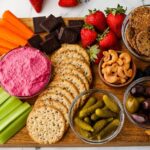Embark on a vibrant culinary journey into the world of raw vegan cuisine! Imagine crafting delicious, nutritious meals without sacrificing speed or simplicity. This guide unveils the secrets to effortless raw vegan cooking, perfect for beginners eager to explore a healthier, plant-based lifestyle. Discover how readily available ingredients transform into breathtaking breakfasts, satisfying lunches, and invigorating dinners, all prepared with minimal effort and maximum flavor.
We’ll demystify the process, guiding you through essential equipment, simple techniques, and a collection of mouthwatering recipes designed for ease and speed. From vibrant breakfast bowls bursting with fresh fruits and nuts to quick-to-assemble lunches and satisfying, yet surprisingly simple, dinners, this guide provides a comprehensive introduction to the delightful world of raw vegan eating. Prepare to be amazed by how quickly and easily you can create stunning, healthy meals.
Essential Tips & Tricks for Raw Vegan Cooking
:max_bytes(150000):strip_icc()/raw-vegan-pad-thai-salad-recipe-3377474-step-03-5c28edb6c9e77c0001d86eac.jpg)
Embarking on a raw vegan culinary journey can feel exciting yet daunting. Mastering the art of preparing delicious and nutritious raw vegan meals doesn’t require years of experience; with a few key techniques and a little practice, you’ll be creating vibrant, flavorful dishes in no time. This section unveils essential tips and tricks to simplify your raw vegan cooking experience, ensuring food safety, and helping you avoid common pitfalls.
Five Essential Tips for Faster and Easier Raw Vegan Cooking
Efficient raw vegan cooking hinges on organization and smart techniques. These five tips will streamline your process and reduce preparation time, allowing you to enjoy the delicious results without the overwhelming effort.
- Mise en Place: Before you begin, meticulously prepare all your ingredients. Wash, chop, and measure everything in advance. This eliminates mid-recipe scrambling and ensures a smooth workflow. Imagine having a colorful array of diced vegetables, pre-soaked nuts, and measured spices neatly arranged on your counter, ready to be combined.
- Utilize Pre-made Ingredients: Leverage commercially available raw vegan products like pre-made nut butters, dehydrated vegetables, and ready-to-blend smoothie mixes. These shortcuts significantly reduce preparation time without compromising quality. Picture a pantry stocked with jars of vibrant nut butters, bags of crunchy dehydrated kale chips, and convenient pouches of superfood blends.
- Embrace Your Food Processor: A high-powered food processor is a raw vegan chef’s best friend. It effortlessly blends, chops, and purees ingredients, making quick work of tasks like creating creamy sauces, nut milks, and veggie patties. Visualize the whirring blades effortlessly transforming raw ingredients into smooth, velvety textures.
- Master Basic Techniques: Focus on mastering a few core techniques like making raw vegan sauces (e.g., cashew cream), preparing simple salads, and creating basic wraps or bowls. Once you’ve mastered these, you can easily adapt them to create a wide variety of meals. Think of it like building blocks – once you understand the basics, the possibilities are endless.
- Plan Your Meals: Planning your meals ahead of time simplifies the cooking process. Creating a weekly menu and shopping list helps you stay organized and ensures you have all the necessary ingredients on hand. Imagine a neatly organized weekly meal plan with vibrant photos of each dish, inspiring you to prepare healthy and delicious raw vegan meals.
Food Safety in Raw Vegan Cooking
Maintaining food safety is crucial when handling raw ingredients, even more so in a raw vegan context where ingredients aren’t subjected to high heat. Thorough washing, proper storage, and mindful handling are essential to prevent foodborne illnesses.
Always wash your hands thoroughly before and after handling any produce. Wash all fruits and vegetables meticulously under running water, scrubbing firm produce with a vegetable brush to remove any dirt or residue. Store raw ingredients appropriately – refrigerate perishable items promptly and ensure proper separation to prevent cross-contamination. Avoid using cutting boards and utensils that have come into contact with raw meat or poultry. Imagine a pristine kitchen, gleaming with cleanliness, where every step is taken to ensure food safety.
Common Mistakes Beginners Make and Suggested Improvements
Beginners often encounter challenges when starting their raw vegan journey. Understanding these common pitfalls and implementing simple solutions can prevent frustration and ensure a smoother experience.
- Over-complicating Recipes: Beginners often choose complex recipes early on. Start with simple, straightforward recipes to build confidence and master fundamental techniques. Gradually introduce more intricate recipes as your skills develop.
- Ignoring Texture: Raw vegan meals can sometimes lack satisfying texture. Incorporate a variety of textures – crunchy, creamy, soft – to create a more enjoyable dining experience. Experiment with different ingredients to achieve a balance of textures.
- Not Balancing Flavors: Raw vegan cooking requires a keen understanding of flavor balance. Don’t be afraid to experiment with different herbs, spices, and acidic elements to create depth and complexity. Taste as you go and adjust seasonings to achieve the desired flavor profile.
- Insufficient Soaking: Many raw vegan recipes call for soaking nuts and seeds to improve digestibility and reduce enzyme inhibitors. Always follow soaking instructions carefully; under-soaked nuts and seeds can be difficult to digest and may negatively impact your digestive health.
Readily Available Raw Vegan Ingredients for Quick Recipes
A well-stocked pantry of readily available raw ingredients is the foundation for quick and easy raw vegan cooking. These ingredients are versatile, readily accessible, and form the basis of countless delicious recipes.
- Avocados: Creamy and versatile, avocados are perfect for smoothies, dips, and as a base for raw vegan desserts.
- Bananas: Naturally sweet and readily available, bananas are ideal for smoothies, nice cream, and quick energy boosts.
- Leafy Greens: Spinach, kale, and romaine lettuce are perfect for salads, wraps, and green smoothies.
- Nuts and Seeds: Almonds, cashews, sunflower seeds, and chia seeds are essential for making nut butters, milk, and adding healthy fats and protein to your meals.
- Vegetables: Carrots, cucumbers, bell peppers, and tomatoes are perfect for salads, wraps, and snacking.
Unlocking the vibrant world of raw vegan cuisine doesn’t require hours in the kitchen or specialized skills. This guide has equipped you with the knowledge and recipes to confidently create delicious, healthy meals quickly and easily. Remember, the journey to a healthier lifestyle is best enjoyed one vibrant, flavorful, raw vegan creation at a time. So, embrace the simplicity, savor the flavors, and relish the journey towards a more vibrant you. Now, go forth and create your raw vegan masterpiece!
Answers to Common Questions
What are the main benefits of a raw vegan diet?
Raw vegan diets are rich in vitamins, minerals, and enzymes, potentially boosting energy levels, improving digestion, and promoting weight management. However, careful planning is crucial to ensure adequate nutrient intake.
Can I use a regular blender for raw vegan recipes?
A high-speed blender is ideal for achieving smooth textures in raw vegan recipes, but a regular blender can work for some recipes, particularly those with less fibrous ingredients.
How long can I store raw vegan meals?
Raw vegan meals should be stored properly refrigerated and consumed within 2-3 days for optimal freshness and safety. Some recipes may have shorter shelf lives due to the ingredients used.
Are there any potential drawbacks to a raw vegan diet?
A poorly planned raw vegan diet may lead to nutrient deficiencies. It’s crucial to ensure a balanced intake of essential nutrients, potentially through supplementation under the guidance of a healthcare professional.


